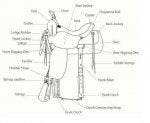Hey all,
Well I have got a 4 year old Thoroughbred X Welsh Section D Gelding called Rico who im currently breaking in.
Anyways, I am in the process of finding an english saddle to fit him as thats how Iv always ridden but after being on here and as most of you seem to be american I have seen lots about western riding and tack and I am very interested!
I was wondering wether people feel breaking in, in english tack is better than western tack or the other way round? Once broken im very tempted to get a western saddle and bridle and give it a try as I will mostly be hacking (trail) but I'd need an english saddle for jumping and competing.
Can anyone tell me how western tack is fitted as I read somewhere that seat size is different to english and the saddles dont have gullet widths. Could be very wrong? I'd also love to know where I could get western tack from that is relatively cheap but nice and quite lightweight- Im in the UK.
Do you reckon its easier 4 a youngster to learn in a lightweight english saddle or do you feel its better to learn in a western saddle then an english will feel like nothing.
ALso, whats the main differences between the two disciplines? EG. Neck reining, spins etc..
Thanks,
Sarah
Well I have got a 4 year old Thoroughbred X Welsh Section D Gelding called Rico who im currently breaking in.
Anyways, I am in the process of finding an english saddle to fit him as thats how Iv always ridden but after being on here and as most of you seem to be american I have seen lots about western riding and tack and I am very interested!
I was wondering wether people feel breaking in, in english tack is better than western tack or the other way round? Once broken im very tempted to get a western saddle and bridle and give it a try as I will mostly be hacking (trail) but I'd need an english saddle for jumping and competing.
Can anyone tell me how western tack is fitted as I read somewhere that seat size is different to english and the saddles dont have gullet widths. Could be very wrong? I'd also love to know where I could get western tack from that is relatively cheap but nice and quite lightweight- Im in the UK.
Do you reckon its easier 4 a youngster to learn in a lightweight english saddle or do you feel its better to learn in a western saddle then an english will feel like nothing.
ALso, whats the main differences between the two disciplines? EG. Neck reining, spins etc..
Thanks,
Sarah








